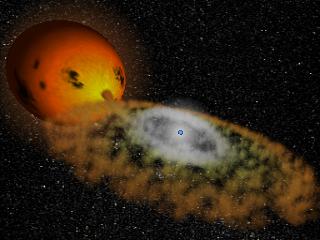2020 May 30
Dwarf nova PQ And undergoes rare outburst

As announced in a recent BAA Alert email, the dwarf nova PQ And was found to be in outburst at mag 10.5 on May 28.776 by Kenji Hirosawa (Aichi, Japan). This means that it is some 9 magnitudes above its usual quiescence of 19.5. PQ And has only been seen in outburst once before when Dave McAdam discovered it as Nova And 1988. So this is its first appearance for 32 years.
Further details on PQ And and its current outburst can be found on the BAA VSS pages. There is also an active Forum thread on the subject.
All observations of this rare outburst are urgently required, both visual and CCD. Time resolved CCD photometry would also be very helpful. It’s of course tricky to observe given the location in the dawn sky, so every observation counts.
Dwarf novae are compact binary stars and as they evolve their orbital period gets shorter until it reaches a minimum around 75 to 80 minutes. The orbital period of PQ And is 80.6 mins. There is some speculation that this might be a rare example of a “period bouncer” in which the system has evolved through the minimum and is increasing.
PQ And is located in Andromeda at RA 02 29 29.55 Dec +40 02 40.0 (J2000.0). A finder chart is available from the AAVSO website. Do try to observe this very rare event. At 10th mag it is visible in a small telescope You might have to wait 32 years for the next one!
Jeremy Shears
Director, BAA Variable Star Section
Dwarf nova graphic courtesy of Dr Andrew Beardmore
| The British Astronomical Association supports amateur astronomers around the UK and the rest of the world. Find out more about the BAA or join us. |
